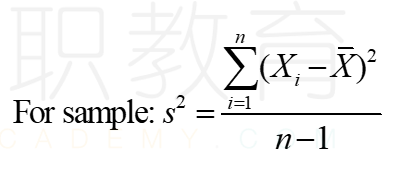NO.PZ2015121802000021
问题如下:
Calculate the standard deviation of annual returns on an investment based on the following chart:

选项:
A.1.2%.
B.4.44%.
C.19.7%.
解释:
B is correct.
Mean annual return = (4% - 3% - 4% + 3% + 6%) / 5 = 1.2%
Squared deviations from the mean:
4%-1.2%=2.8% (2.8%)2= 7.84
-3% -1.2% = -4.2% (-4.2%)2 = 17.64
-4% -1.2% = -5.2% (-5.2%)2 = 27.04
3% -1.2% =1.8% (1.8%)2= 3.24
6% -1.2% = 4.8% (4.8%) 2= 23.04
Sum of squared deviations = 7.84 + 17.64 + 27.04 + 3.24+ 23.04 = 78.8
Sample variance = 78.8/(5 - 1) = 19.7
Sample standard deviation = 19.71/2= 4.44%
第二个问题,为啥sample是除以n-1,数量学科有这个公式但太久了记不清了,谢谢老师




